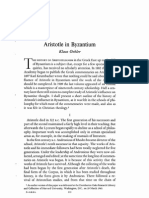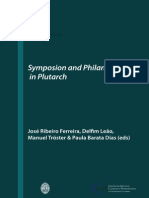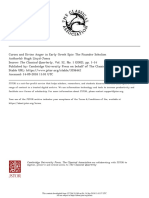Cautes and Cautopates
Cautes and Cautopates
Uploaded by
Mathieu RBCopyright:
Available Formats
Cautes and Cautopates
Cautes and Cautopates
Uploaded by
Mathieu RBCopyright
Available Formats
Share this document
Did you find this document useful?
Is this content inappropriate?
Copyright:
Available Formats
Cautes and Cautopates
Cautes and Cautopates
Uploaded by
Mathieu RBCopyright:
Available Formats
Cautes and Cautopates
Cautes and Cautopates
Cautes and Cautopates are torch-bearers depicted attending the god Mithras in the icons of ancient Roman cult of Mithraism, known as Tauroctony. Cautes holds his torch raised up, and Cautopates holds his torch downward.
Interpretation
In Mithraic images Mithras either represents the sun, or is a close friend of the sun god Helios or Sol Invictus (Latin: the invincible sun) with whom Mithras dines. So attendants Cautes and Cautopates are supposed to either represent the stations of sunrise and sunset respectively, or perhaps the spring and autumn equinoxes.
Depictions
Both are depicted as smaller than Mithras to emphasize his significance, and both wear Persian style garments, notably a Phrygian cap, to emphasize the supposed oriental origins of the cult.[1] Cautes holds a burning torch pointed up, whereas Cautopates holds a burning torch pointed down.[2] Cautopates is usually depicted on the left, but not always.
Fiano Romano mithraic relief
The two torch-bearers are often interpreted as symbols of light, one for the rising, the other for the setting sun.[3] Cautopates could also represent death, while Cautes might represent new life.[4] An alternate interpretation advanced by David Ulansey is that Cautes represents the spring equinox and Cautopates the autumn equinox. Thus, represented on the left and right of the Tauroctony, they become a realistic cadre of the celestial equator and the constellations included between the two equinoxes during the Age of Taurus.
References
[1] See Mithraism for a fuller discussion. See also: Cumont, Franz. Oriental Religions in Roman Paganism (1911) [2] Manfred Claus, The Roman cult of Mithras, tr. Richard Gordon. Edinburgh University Press (2000) p.95: "No satisfactory etymology of the names Cautes and Cautopates has yet been offered, but it is certain which name applied to which: Cautes holds his torch up, Cautopates down. That it was possible to represent them sometimes simply by their phrygian caps shows that the Mithraists took their presence for granted (p. 49; fig. 9)." [3] Manfred Clauss, The Roman cult of Mithras, tr. R. Gordon, Edinburgh University Press (2000) p.95-6. [4] Manfred Clauss, The Roman cult of Mithras, p.97.
External links
UCL, Mithras (http://search2.ucl.ac.uk/search/search.cgi?query=mithras&collection=ucl-public-meta)
Article Sources and Contributors
Article Sources and Contributors
Cautes and Cautopates Source: http://en.wikipedia.org/w/index.php?oldid=535870482 Contributors: Amalas, Catalographer, CommonsDelinker, Fabioli2010, FinnWiki, Gekritzl, Jeff3000, Lotje, Mboverload, Pydos, Roger Pearse, T of Locri, Yahel Guhan, 7 anonymous edits
Image Sources, Licenses and Contributors
Image:Fiano Romano mithraic relief.jpg Source: http://en.wikipedia.org/w/index.php?title=File:Fiano_Romano_mithraic_relief.jpg License: Creative Commons Attribution-ShareAlike 3.0 Unported Contributors: User:PHGCOM
License
Creative Commons Attribution-Share Alike 3.0 Unported //creativecommons.org/licenses/by-sa/3.0/
You might also like
- Zeus Polieus and ArtemisDocument3 pagesZeus Polieus and Artemisjale kitapNo ratings yet
- Carpenter Phileban GodsDocument20 pagesCarpenter Phileban GodsEsteban F.No ratings yet
- Tomlison Perachora: The Remains Outside The Two Sanctuaries 1969 PDFDocument129 pagesTomlison Perachora: The Remains Outside The Two Sanctuaries 1969 PDFAnonymousNo ratings yet
- City and Empire in the Age of the Successors: Urbanization and Social Response in the Making of the Hellenistic KingdomsFrom EverandCity and Empire in the Age of the Successors: Urbanization and Social Response in the Making of the Hellenistic KingdomsNo ratings yet
- Phrygian CapDocument8 pagesPhrygian CapMathieu RB100% (1)
- Orphism (Religion)Document6 pagesOrphism (Religion)Mathieu RBNo ratings yet
- The Tradition of Stephanus Byzantius PDFDocument17 pagesThe Tradition of Stephanus Byzantius PDFdumezil3729No ratings yet
- Smoothing Over The Differences: Proclus and Ammonius On Plato'S AND Aristotle'SDocument11 pagesSmoothing Over The Differences: Proclus and Ammonius On Plato'S AND Aristotle'SNițceValiNo ratings yet
- Ancient Use of The Knuckle-Bone For Rituals and Gaming PieceDocument11 pagesAncient Use of The Knuckle-Bone For Rituals and Gaming PieceVictor M GonzalezNo ratings yet
- 9783110575200.de Gruyter - Greeks, Books and Libraries in Renaissance Venice - Jul.2021Document413 pages9783110575200.de Gruyter - Greeks, Books and Libraries in Renaissance Venice - Jul.2021Vaan HoolNo ratings yet
- Marco Ercoles. Aeschylus' Scholia and The Hypomnematic Tradition: An InvestigationDocument43 pagesMarco Ercoles. Aeschylus' Scholia and The Hypomnematic Tradition: An InvestigationΘεόφραστος100% (1)
- The Four Causes. Aristotle's Exposition and AncientsDocument5 pagesThe Four Causes. Aristotle's Exposition and AncientsSergio Andrés VahosNo ratings yet
- Athenian Agora 25 (1990) OstrakaDocument244 pagesAthenian Agora 25 (1990) OstrakaDiphilusNo ratings yet
- M. Schofield - DiakosmesisDocument46 pagesM. Schofield - DiakosmesisSontinetteNo ratings yet
- 986213Document29 pages986213Mike SevekhNo ratings yet
- The Absence of The Moon in The Mithras LiturgyDocument2 pagesThe Absence of The Moon in The Mithras LiturgyMathieu RBNo ratings yet
- Dr. Rudolf Habelt GMBH, Bonn (Germany)Document6 pagesDr. Rudolf Habelt GMBH, Bonn (Germany)Δημήτριος Μετζικώφ ΠαπαδάκηςNo ratings yet
- Aristotle in Byzantium: Klaus OehlerDocument14 pagesAristotle in Byzantium: Klaus OehlerMihai FaurNo ratings yet
- Stesichorus Palinode in The Phaedrus PDFDocument16 pagesStesichorus Palinode in The Phaedrus PDFAlex MadisNo ratings yet
- Cyrilli Alexandrini - Contra IulianumDocument338 pagesCyrilli Alexandrini - Contra Iulianum123KalimeroNo ratings yet
- Philodemus On Franj CriticismDocument204 pagesPhilodemus On Franj CriticismLucasMinervinoNo ratings yet
- The Theology of The Epinomis (Vera Calchi) (Z-Library)Document224 pagesThe Theology of The Epinomis (Vera Calchi) (Z-Library)Prometheus AlberioneNo ratings yet
- The Illustrated Method of ArchimedesDocument48 pagesThe Illustrated Method of Archimedesalex2951No ratings yet
- Finkelberg A Anaximander's Conception of The ApeironDocument29 pagesFinkelberg A Anaximander's Conception of The ApeironValentina Murrocu100% (2)
- Adkins (The Connection Between Aristotle's Ethics and Politics)Document22 pagesAdkins (The Connection Between Aristotle's Ethics and Politics)DiegoNo ratings yet
- Mueller, Ian - Iamblichus and Proclus' Euclid CommentaryDocument15 pagesMueller, Ian - Iamblichus and Proclus' Euclid CommentaryAlexMartínVidalNo ratings yet
- Agapitos PDFDocument57 pagesAgapitos PDFAnastasiya MazepaNo ratings yet
- Plato Charmides. Translated With Introdu PDFDocument8 pagesPlato Charmides. Translated With Introdu PDFdonwea25No ratings yet
- Usher, Satyr Play in Plato's SymposiumDocument25 pagesUsher, Satyr Play in Plato's SymposiumNikos HarokoposNo ratings yet
- Hutchinson, D.S. Ransome Johnson, Monte (Eds.) - Aristotle Protrepticus or Exhortation To Philosophy PDFDocument91 pagesHutchinson, D.S. Ransome Johnson, Monte (Eds.) - Aristotle Protrepticus or Exhortation To Philosophy PDFLuiz BruderNo ratings yet
- Zeno and Stoic Consistency. J. Rist. 1977 PDFDocument15 pagesZeno and Stoic Consistency. J. Rist. 1977 PDFUlisesRochaNo ratings yet
- Adkins: Merit, Responsibility, and ThucydidesDocument13 pagesAdkins: Merit, Responsibility, and ThucydidesrmvicentinNo ratings yet
- Plato's Phaedrus R. Hackforth Plato's Phaedrus. Translated With Introduction and Commentary. Tate, JDocument3 pagesPlato's Phaedrus R. Hackforth Plato's Phaedrus. Translated With Introduction and Commentary. Tate, JCy PercutioNo ratings yet
- Timaeus LocrusDocument18 pagesTimaeus LocrusZhennya SlootskinNo ratings yet
- Symposion and Philanthropia in PlutarchDocument557 pagesSymposion and Philanthropia in PlutarchStefano Amendola100% (1)
- Diatribe and Plutarchs Practical EthicsDocument129 pagesDiatribe and Plutarchs Practical EthicsEdelberto Pauli JúniorNo ratings yet
- Menander Protector Fr. 6.1-3Document14 pagesMenander Protector Fr. 6.1-3Mehmet TezcanNo ratings yet
- Heidel 1909 - The ἄναρμοι ὄγκοι of Heraclides and AsclepiadesDocument17 pagesHeidel 1909 - The ἄναρμοι ὄγκοι of Heraclides and AsclepiadesVincenzodamianiNo ratings yet
- The History of A Greek ProverbDocument32 pagesThe History of A Greek ProverbAmbar CruzNo ratings yet
- Stoic Logicians BiblioDocument8 pagesStoic Logicians BiblioumityilmazNo ratings yet
- Protrepticus: Compiled by D. S. Hutchinson and Monte Ransome Johnson Version of 2011vi22Document15 pagesProtrepticus: Compiled by D. S. Hutchinson and Monte Ransome Johnson Version of 2011vi22Ciça Vicente de AzevedoNo ratings yet
- Prosodic Words: Sharon PeperkampDocument6 pagesProsodic Words: Sharon PeperkampTwana1No ratings yet
- The Ithyphallic Hymn For Demetrios Polio PDFDocument43 pagesThe Ithyphallic Hymn For Demetrios Polio PDFKaterinaLogothetiNo ratings yet
- Plato and The Concept of The Soul (Psyche)Document14 pagesPlato and The Concept of The Soul (Psyche)spinoza32No ratings yet
- Wynne - Cicero On The Philosophy of Religion PDFDocument320 pagesWynne - Cicero On The Philosophy of Religion PDFgalenusNo ratings yet
- The Neolithic Settlement at Makriyalos, Northern Greece: Preliminary Report On The 1993 - 1995 ExcavationsDocument20 pagesThe Neolithic Settlement at Makriyalos, Northern Greece: Preliminary Report On The 1993 - 1995 ExcavationsDimitra KaiNo ratings yet
- Alexander P.D. Mourelatos - Victor Caston - Daniel W. Graham - Presocratic Philosophy - Essays in Honour of Alexander Mourelatos-Routledge (2002)Document364 pagesAlexander P.D. Mourelatos - Victor Caston - Daniel W. Graham - Presocratic Philosophy - Essays in Honour of Alexander Mourelatos-Routledge (2002)dananovakrizoNo ratings yet
- Robinson - Alexander's IdeasDocument20 pagesRobinson - Alexander's IdeasJames L. Kelley100% (1)
- HomeroDocument18 pagesHomeroClaudiaMartínezNo ratings yet
- The Fall of The Sothic TheoryDocument4 pagesThe Fall of The Sothic Theorylove1scribd100% (1)
- Plato and The PaintersDocument21 pagesPlato and The PaintersZhennya SlootskinNo ratings yet
- 1998 - William Prior - A New Apology PDFDocument8 pages1998 - William Prior - A New Apology PDFAlice SilvaNo ratings yet
- Broggiato - 2011 - Artemon of Pergamum (FGRH 569) - 1Document8 pagesBroggiato - 2011 - Artemon of Pergamum (FGRH 569) - 1philodemusNo ratings yet
- Curses and Divine Anger in Early Greek EpicDocument15 pagesCurses and Divine Anger in Early Greek EpicAlvah GoldbookNo ratings yet
- Quine - 1985 - Events and ReificationDocument5 pagesQuine - 1985 - Events and ReificationMohammed LiNo ratings yet
- In Tim. III P. 333. 23 Fff. and Simpl. (?) in de An. P. 5. 33 FFF., P. 89. 22 FFF., P. 240. 33 FFF., P. 313. 1 FFFDocument6 pagesIn Tim. III P. 333. 23 Fff. and Simpl. (?) in de An. P. 5. 33 FFF., P. 89. 22 FFF., P. 240. 33 FFF., P. 313. 1 FFFblavskaNo ratings yet
- Gagarin - Dike in Archaic Greek ThoughtDocument13 pagesGagarin - Dike in Archaic Greek ThoughtAmanda Beatriz LanesNo ratings yet
- Henry Chadwick Boethius The Consolations of MusicDocument349 pagesHenry Chadwick Boethius The Consolations of MusicCristeaNo ratings yet
- A Woman Homer SungDocument2 pagesA Woman Homer SungGirlhappy RomyNo ratings yet
- Allegoryinstoicismandplatonism PDFDocument37 pagesAllegoryinstoicismandplatonism PDFanon_243369186No ratings yet
- The City as Comedy: Society and Representation in Athenian DramaFrom EverandThe City as Comedy: Society and Representation in Athenian DramaNo ratings yet
- The Temple of Mithras, Hadrian's WallDocument3 pagesThe Temple of Mithras, Hadrian's WallMathieu RBNo ratings yet
- The Mithras LiturgyDocument6 pagesThe Mithras LiturgyMathieu RBNo ratings yet
- The Four Winds in MithraismDocument5 pagesThe Four Winds in MithraismMathieu RBNo ratings yet
- The Legacy of MithraismDocument11 pagesThe Legacy of MithraismMathieu RBNo ratings yet
- Rome and The Mithraic MysteriesDocument2 pagesRome and The Mithraic MysteriesMathieu RBNo ratings yet
- Volken - Mithras Socio Archaeological.2004Document20 pagesVolken - Mithras Socio Archaeological.2004TomaszUchańskiNo ratings yet
- Mithras The PersianDocument4 pagesMithras The PersianMathieu RBNo ratings yet
- The Absence of The Moon in The Mithras LiturgyDocument2 pagesThe Absence of The Moon in The Mithras LiturgyMathieu RBNo ratings yet
- Neo Mithraic MysteriesDocument8 pagesNeo Mithraic MysteriesMathieu RBNo ratings yet
- Mithras and MithraismDocument7 pagesMithras and MithraismMathieu RBNo ratings yet
- Further Guidelines For The Modern Practice of MithraismDocument10 pagesFurther Guidelines For The Modern Practice of MithraismMathieu RB100% (1)
- (D.Ulansey) Cosmic Mysteries of Mithras Mithraism Ancient ReligionDocument19 pages(D.Ulansey) Cosmic Mysteries of Mithras Mithraism Ancient Religionuchujaro100% (1)
- World EggDocument4 pagesWorld EggMathieu RBNo ratings yet
- Mithraism in The Private & Public Lives of 4th-c. Senators in RomeDocument7 pagesMithraism in The Private & Public Lives of 4th-c. Senators in RomeMathieu RBNo ratings yet
- SyncretismDocument9 pagesSyncretismMathieu RBNo ratings yet
- Roman TempleDocument6 pagesRoman TempleMathieu RBNo ratings yet
- Roman LondonDocument10 pagesRoman LondonMathieu RBNo ratings yet
- Mithras LiturgyDocument3 pagesMithras LiturgyMathieu RBNo ratings yet
- Roman EmpireDocument66 pagesRoman EmpireMathieu RB100% (1)
- Sol InvictusDocument9 pagesSol InvictusMathieu RBNo ratings yet
- Religion in Ancient RomeDocument30 pagesReligion in Ancient RomeMathieu RB50% (2)
- Mithras in Comparison With Other Belief SystemsDocument6 pagesMithras in Comparison With Other Belief SystemsMathieu RBNo ratings yet
- Phanes (Mythology)Document2 pagesPhanes (Mythology)Mathieu RBNo ratings yet
- Mitra (Vedic)Document3 pagesMitra (Vedic)Mathieu RBNo ratings yet




















































































